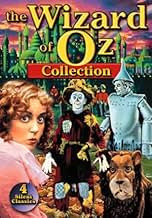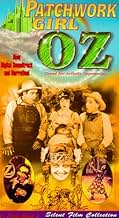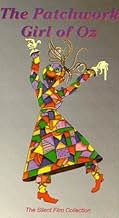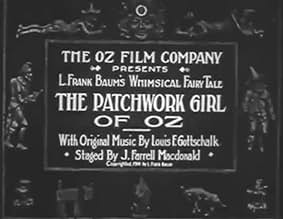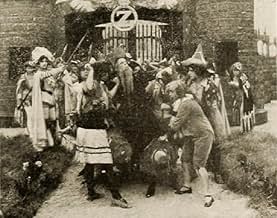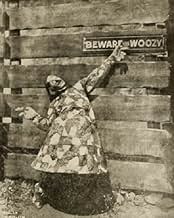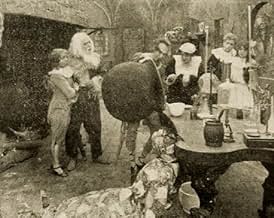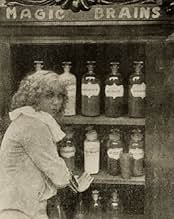Aggiungi una trama nella tua linguaOjo and Unc Nunkie are out of food, so they decide to journey to the Emerald City where they will never starve.Ojo and Unc Nunkie are out of food, so they decide to journey to the Emerald City where they will never starve.Ojo and Unc Nunkie are out of food, so they decide to journey to the Emerald City where they will never starve.
Leontine Dranet
- Margolotte, his wife, who makes the Patchwork Girl
- (as Haras Dranet)
Richard Rosson
- Danx, a Noble Munchkin
- (as Dick Rosson)
Bert Glennon
- The Scarecrow
- (as Herbert Glennon)
Hal Roach
- The Cowardly Lion
- (as Al Roach)
- …
Dave Anderson
- The Hungry Tiger
- (as Andy Anderson)
Pierre Couderc
- Scraps, the Patchwork Girl
- (as The Marvelous Couderc)
Recensioni in evidenza
The recent phenomenon of Harry Potter isn't so unusual. An early case it the amazing popularity of Oz.
The books, the first ones, became popular, amazingly so. By some measures more popular than Potter. They are simple: children, a magical land rather a land like ours in many ways but with magic and magical creatures.
Then the movies started. Magic sells cinematically when the world is like the one we live in plus magic that matches what the camera can emulate. When the writer understands the overlap, he or she can write books that are cinematically rooted. Each feeds the other. Each feeds the juvenile imagination.
You should watch this. Because with distance, you can see how shallow that imagination is. The effects of today's movies are better, but they are no less believable to us than these were in their day. Let that soak in and you'll get pretty depressed about the current Potter phenomenon (and probably increase your appreciation for the "Rings" works).
Ted's Evaluation -- 2 of 3: Has some interesting elements.
The books, the first ones, became popular, amazingly so. By some measures more popular than Potter. They are simple: children, a magical land rather a land like ours in many ways but with magic and magical creatures.
Then the movies started. Magic sells cinematically when the world is like the one we live in plus magic that matches what the camera can emulate. When the writer understands the overlap, he or she can write books that are cinematically rooted. Each feeds the other. Each feeds the juvenile imagination.
You should watch this. Because with distance, you can see how shallow that imagination is. The effects of today's movies are better, but they are no less believable to us than these were in their day. Let that soak in and you'll get pretty depressed about the current Potter phenomenon (and probably increase your appreciation for the "Rings" works).
Ted's Evaluation -- 2 of 3: Has some interesting elements.
The most famous movie adaptation of a novel by L. Frank Baum entails Toto, a tornado, ruby slippers and a yellow brick road. Well, it turns out that Victor Fleming's 1939 adaptation was not the first. An earlier screen version of "The Wizard of Oz" was a 1925 loose adaptation of the story, notable for casting Oliver Hardy as the Tin Woodsman.
And then there were the adaptations in which Baum himself participated. He founded the Oz Film Manufacturing Company and made some movie versions of his novels. These aren't the most sophisticated adaptations but are worth seeing as a look into early cinema. "The Patchwork Girl of Oz" features things like people getting turned into statues (and one of them getting shrunken down so that a woman can carry him). Yeah, Baum came up with some wacky stuff.
One interesting thing about this movie is that the lion is played by none other than Hal Roach, best known as the producer of Laurel & Hardy's movies. It appears that only Stan Laurel didn't get to go to Oz on the silver screen. Of course, I can't picture him in Oz without imagining that he would have turned everything upside down. In other words, it would have been another fine mess that he'd gotten himself into!
Anyway, this movie is worth seeing. I wonder what Baum would have thought of the most famous adaptation of his work, had he lived to see it.
And then there were the adaptations in which Baum himself participated. He founded the Oz Film Manufacturing Company and made some movie versions of his novels. These aren't the most sophisticated adaptations but are worth seeing as a look into early cinema. "The Patchwork Girl of Oz" features things like people getting turned into statues (and one of them getting shrunken down so that a woman can carry him). Yeah, Baum came up with some wacky stuff.
One interesting thing about this movie is that the lion is played by none other than Hal Roach, best known as the producer of Laurel & Hardy's movies. It appears that only Stan Laurel didn't get to go to Oz on the silver screen. Of course, I can't picture him in Oz without imagining that he would have turned everything upside down. In other words, it would have been another fine mess that he'd gotten himself into!
Anyway, this movie is worth seeing. I wonder what Baum would have thought of the most famous adaptation of his work, had he lived to see it.
L. Frank Baum himself produced and wrote this adaptation of his own Oz book, a full quarter century before Judy Garland strolled the yellow brick road. What survives is an intriguing artifact from cinema's infancy, antiquated in style and naive in sentiment, but compensating with plenty of charm for what it lacks in sophistication. The influence of theater can still be seen in the histrionic acting and static camera set-ups, but the affection Baum lavished on his creations (munchkins, magicians, 'hoppers', the 'woozy') is clearly evident, even today. His fertile imagination, reinforced by some clever (if primitive) camera tricks, makes this an enchanting fantasy with more than merely academic interest for students of early film history.
You really have to look at "The Patchwork Girl of Oz" in context, otherwise you'll just dismiss it as a dull and incomprehensible movie. But, back in 1914, it was a rather impressive tale--but one that even audiences back then probably struggled to understand unless they'd read the Frank Baum story. Heck, I tried watching it was was TOTALLY confused until I read a summary of the story on the internet! That's because the narrative is really scant--with almost no intertitle cards. Instead, it's shown as a series of tenuously connected vignettes which are described on the card and then acted out...as was the style up until about 1914 or a bit later. It comes off almost like a slide show that is acted out for the audience! This certainly is NOT all that entertaining and too often the characters just cavort about aimlessly or do acrobatics instead of acting--and it comes off pretty poorly. BUT, again, it was pretty much the style of the day. The ladies in the film and sets and 'magic' were pretty similar to the work done a decade earlier by the groundbreaking French film maker Georges Méliès. By 1914, these amazing effects and story telling really were a a bit passé--definitely on their way out--which might explain why the film was a critical flop--that, and the fact that the audience probably had no idea what was occurring on screen! Interesting from a historical perspective and having excellent production values for the time, but still very easy to skip unless you adore very early silent films.
As a child, The Patchwork Girl of Oz was my favorite Oz book. This silent film version is a charming look at how Oz was envisioned by it's creator--L. Frank Baum produced the film. The story however does stray from the book and some of the scenes are a bit disjointed. Motion pictures were in their infancy in 1914--most films were stagebound dramas, so to see a fantasy film from this period is unique.
The Patchwork Girl or "Scraps" is played by French acrobat Pierre Couderc. The part where Scraps catches the eye of the Scarecrow is very amusing. Also, the Yoop character is a forerunner to the Winged Monkeys who terrorized Judy Garland 25 years later.
In the video version I saw, the pivotal scene where Scraps is brought to life and tips over the Liquid of Petrification, is missing or destroyed--but the rest of the film is intact however.
The Patchwork Girl or "Scraps" is played by French acrobat Pierre Couderc. The part where Scraps catches the eye of the Scarecrow is very amusing. Also, the Yoop character is a forerunner to the Winged Monkeys who terrorized Judy Garland 25 years later.
In the video version I saw, the pivotal scene where Scraps is brought to life and tips over the Liquid of Petrification, is missing or destroyed--but the rest of the film is intact however.
Lo sapevi?
- QuizHarold Lloyd and Hal Roach, who both have minor roles in this film, met on this set in San Diego. Roach was impressed by Lloyd's energy and sought him out when he formed his production company The Rolin Film Company in July 1914 after receiving a small inheritance. Although their association was stormy, their association was ultimately one of the most successful in silent film history.
- BlooperThe character of Ojo is stated several times to be a boy, but is referred to as a girl in one of the dialogue caption cards.
- ConnessioniFeatured in American Masters: Harold Lloyd: The Third Genius (1989)
I più visti
Accedi per valutare e creare un elenco di titoli salvati per ottenere consigli personalizzati
- How long is The Patchwork Girl of Oz?Powered by Alexa
Dettagli
- Tempo di esecuzione1 ora 21 minuti
- Colore
- Mix di suoni
- Proporzioni
- 1.33 : 1
Contribuisci a questa pagina
Suggerisci una modifica o aggiungi i contenuti mancanti

Divario superiore
By what name was The Patchwork Girl of Oz (1914) officially released in Canada in English?
Rispondi
